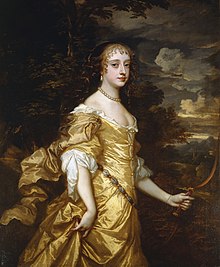
Lady Sarah Lennox was the most notorious of the famous Lennox sisters, daughters of Charles Lennox, 2nd Duke of Richmond and Sarah Cadogan.

The House of Stuart, originally spelled Stewart, was a royal house of Scotland, England, Ireland and later Great Britain. The family name comes from the office of High Steward of Scotland, which had been held by the family progenitor Walter fitz Alan. The name Stewart and variations had become established as a family name by the time of his grandson Walter Stewart. The first monarch of the Stewart line was Robert II, whose male-line descendants were kings and queens in Scotland from 1371, and of England, Ireland and Great Britain from 1603, until 1714. Mary, Queen of Scots, was brought up in France where she adopted the French spelling of the name Stuart.
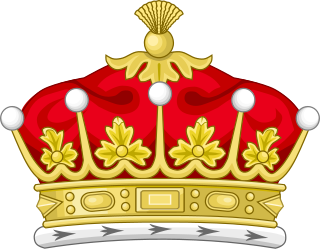
Earl of Lichfield is a title that has been created three times, twice in the Peerage of England and once in the Peerage of the United Kingdom (1831). The third creation is extant and is held by a member of the Anson family.

Barbara Palmer, 1st Duchess of Cleveland, Countess of Castlemaine, was an English royal mistress of the Villiers family and perhaps the most notorious of the many mistresses of King Charles II of England, by whom she had five children, all of them acknowledged and subsequently ennobled. Barbara was the subject of many portraits, in particular by court painter Sir Peter Lely.

Charlotte Lee, Countess of Lichfield, formerly Lady Charlotte Fitzroy, was the illegitimate daughter of King Charles II of England by one of his best known mistresses, Barbara Villiers, 1st Duchess of Cleveland. Known for her beauty, Charlotte was married at age 12 to her husband, Edward Henry Lee, 1st Earl of Lichfield, with whom she had a large family.

Charles Lennox, 1st Duke of Richmond, 1st Duke of Lennox, of Goodwood House near Chichester in Sussex, was the youngest of the seven illegitimate sons of King Charles II, and was that king's only son by his French-born mistress Louise de Kérouaille, Duchess of Portsmouth. He was appointed Hereditary Constable of Inverness Castle.

The Earl or Mormaer of Lennox was the ruler of the region of the Lennox in western Scotland. It was first created in the 12th century for David of Scotland, Earl of Huntingdon and later held by the Stewart dynasty.

Ludovic Stewart, 2nd Duke of Lennox and 1st Duke of Richmond, Lord of the Manor of Cobham, Kent, was a Scottish nobleman who through their paternal lines was a second cousin of King James VI of Scotland and I of England. He was involved in the Plantation of Ulster in Ireland and the colonization of Maine in New England. Richmond's Island and Cape Richmond as well as Richmond, Maine, are named after him. His magnificent monument with effigies survives in Westminster Abbey.

Charles Stewart, 3rd Duke of Richmond KG was an English peer who was the fourth cousin of Charles II of England, being both descended in the male line from John Stewart, 3rd Earl of Lennox.

Esmé Stewart, 3rd Duke of Lennox, KG, 7th Seigneur d'Aubigny, lord of the Manor of Cobham, Kent, was a Scottish nobleman and through their paternal lines was a second cousin of King James VI of Scotland and I of England. He was a patron of the playwright Ben Jonson who lived in his household for five years.

Lennoxlove House is a historic house set in woodlands half a mile south of Haddington in East Lothian, Scotland. The house comprises a 15th-century tower, originally known as Lethington Castle, and has been extended several times, principally in the 17th, 19th and 20th centuries. The house is protected as a category A listed building, and is described by Historic Scotland as "one of Scotland's most ancient and notable houses." The wooded estate is included on the Inventory of Gardens and Designed Landscapes in Scotland, the national listing of significant gardens.

Duke of Aubigny is a title that was created in the Peerage of France in 1684. It was granted by King Louis XIV of France to Louise de Kérouaille, the last mistress of King Charles II of England, and to descend to Charles's illegitimate issue by her, namely to the descendants of Charles Lennox, 1st Duke of Richmond, 1st Duke of Lennox (1672–1723) of Goodwood House in Sussex. Louis XIV also granted her the Château de la Verrerie, a former secondary seat of the Stewart Seigneurs d'Aubigny, Franco-Scottish cousins of the Stewart monarchs, seated from 1422 to 1672 at the Château d'Aubigny in the parish and manor of Aubigny-sur-Nère in the ancient province of Berry in France.

Elizabeth Wilmot, Countess of Rochester was an English heiress and the wife of John Wilmot, 2nd Earl of Rochester, the "libertine". She was the daughter of John Malet, of Enmore Manor, and Unton Hawley, daughter of Francis Hawley, 1st Baron Hawley.
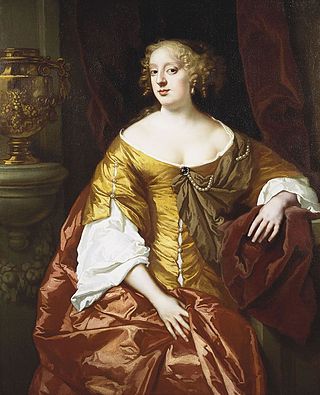
The Windsor Beauties are a set of portrait paintings, still in the Royal Collection, by Sir Peter Lely and his workshop, produced in the early to mid-1660s, that depict ladies of the court of King Charles II, some of whom were his mistresses. The name stems from the original location of the collection, which was at Windsor Castle. In 2024, they were on display at Hampton Court Palace.
Events from the year 1672 in England.
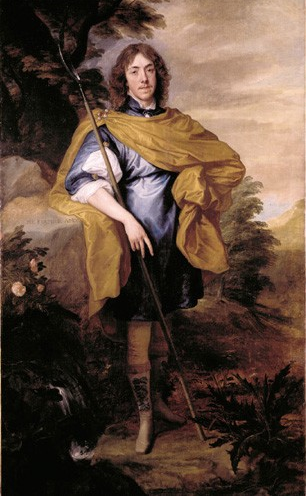
Lord George Stewart, 9th Seigneur d'Aubigny was an Anglo-Scottish nobleman of French descent and a third cousin of King Charles I of England. He supported that king during the Civil War as a Royalist commander and was killed, aged 24, at the Battle of Edgehill in 1642.

Frances Stewart (née Howard), Duchess of Lennox and Richmond, Countess of Hertford was the daughter of a younger son of the Duke of Norfolk. An orphan of small fortune, she rose to be the only duchess at the court of James I of England. She married the son of a London alderman who died in 1599, leaving her a wealthy widow at a young age. She became, for 20 years, the third wife of the ageing Edward Seymour, 1st Earl of Hertford, nephew of Jane Seymour, third queen consort of Henry VIII. Within months of Edward's death she married a cousin of James I, Ludovic Stewart, 2nd Duke of Lennox and 1st Duke of Richmond. One of the great beauties of the Jacobean court, she was also the patron of Captain John Smith of the Virginia Colony.
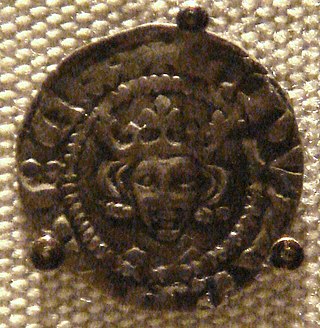
The English farthing was a coin of the Kingdom of England worth 1⁄4 of a penny, 1⁄960 of a pound sterling. Until the 13th century, farthings were pieces of pennies that had been cut into quarters to make change. The first English farthing coins were minted in the 13th century, and continued to be struck until the early 18th century, when England merged into the Kingdom of Great Britain in 1707.

The Château de la Verrerie is a château in Oizon, in the ancient province of Berry in France. It is an historic ancestral seat of a junior branch of the Scottish House of Stewart, known by the territorial title Seigneur d'Aubigny. It is situated about 14 miles south-east of Aubigny-sur-Nère, and the Château d'Aubigny, the original seat of its owners.

Margaret, Lady Denham, formerly the Honourable Margaret Brooke, was an English courtier during the reign of King Charles II of England and was one of the "Windsor Beauties" painted by Sir Peter Lely. She was a mistress of the future King James II of England.
